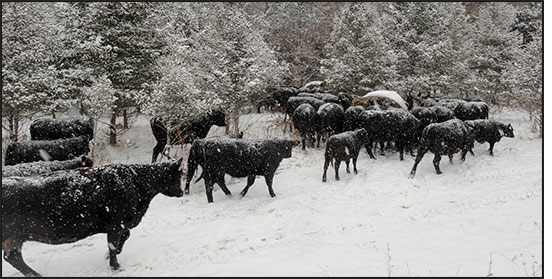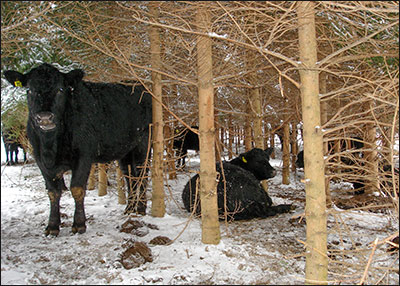
A Living Barn
Protect cattle from winter weather; turn a profit on your investment.
Angus Glen Farms, a registered-Angus operation in upstate New York, uses no barns, lean-tos, windbreaks or any other man-made structure to protect cattle during harsh New York winter weather. Instead, the 100-head farm uses growing and appreciating tree stands.
Affectionately referred to as “living barns,” Brett Chedzoy, owner of Angus Glen, says when he calculated the cost of building a shelter structure vs. investing in the natural resources (trees) around him, it was clear that dense conifer tree stands were the more cost-effective option.
Because they employ a naturally growing and often already-existing resource, living barns are a cost-effective way of providing shelter for livestock, says Chedzoy. A living barn or wooded shelter area can be created from natural wooded areas already on the farm or ranch or from plantation trees. Yet tree age and size will be a factor in designating appropriate living-barn areas.

Living-barn size is also relative to the operation’s needs and the number of times the area is used, says Brett Chedzoy.
“The value of a living barn as a shelter is proportional to the size of the trees and the density of the trees,” Chedzoy explains.
Obviously, well-stocked areas of larger trees offer the best winter protection.
Living-barn size is also relative to the operation’s needs and the number of times the area is used, says Chedzoy.
“If the animals fit into it during a bad winter storm, it’s big enough,” he advises. “If they can be protected by the trees, it’s big enough, but bigger is better because you want the animals to be able to move around.”
Bunching cattle under the same trees too often will stress the cattle and stress the trees, he emphasizes.
“If one area repeatedly takes abuse, you may start to lose those trees.”
Chedzoy also mentions living barns can be created/managed as shelter for things other than cattle. He lists timber, windbreaks, aesthetic beauty, wildlife habitat and shade for farm machinery as alternative uses.
Managing partner of Black Queen Angus Farm LLC in Berlin, N.Y., Morgan Hartman says in addition to using his living barns as wintertime shelters for the last 10 years, he also includes wooded streambeds in his summer grazing rotation for hot, humid weather.
He cites a week in July that had temperatures in the low to mid-90s and humidity around 85%-90%.
“The cattle did fine because they were in the shade. They had access to water. They were grazing in the middle of the day,” says Hartman.
He partly attributes the grazing behavior during high-heat periods to his holistic planned grazing strategy, but doesn’t discount the advantage of having plenty of shade and water for the cattle.
Besides providing protection in the winter, the trees that comprise the living barn are actually appreciating assets to the farm or ranch.
Chedzoy says, “Trees are growing, and they’re therefore increasing in volume and usually in value, as well. The bigger trees get, the more they’re worth. They are going from being a little tree that’s worth nothing, to a pulpwood-sized tree that’s worth a little bit, or a firewood-sized tree that’s worth a little bit, to a saw-timber tree that can become quite valuable.”
Lately, when doing thinning cuts amongst his conifer trees, Hartman has found the wood-shavings market to be profitable.
“The living barn is an asset that will appreciate over time versus depreciate like most roofed structures would,” Chedzoy concludes.
For a more in-depth look at using living shelters, see the full story in the December-January edition of the Angus Beef Bulletin.

Editor’s Note: Paige Nelson is a freelance writer and cattlewoman from Rigby, Idaho.





